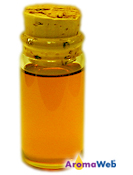Blood Orange Essential Oil
Citrus sinensis

The blood orange is an intriguing variety of sweet orange, and it shares the same botanical name, Citrus sinensis. The blood orange is named as such because its fruit segments are blood red in color.

Description
Aromatically, both Sweet Orange Essential Oil and Blood Orange Oil are similar. However, Blood Orange Essential Oil is a bit more tantalizing, bright and tart.
As the aromatic and therapeutic properties are similar, Blood Orange Essential Oil can be used in place of Sweet Orange Oil in both aromatic and therapeutic blends.
Blood Orange Essential Oil Benefits and Uses
Please refer to the profile for Sweet Orange Essential Oil.
Botanical Name
Plant Family
Common Method of Extraction
Cold Pressed/Expressed
Plant Part Typically Used

Color
Ranges from Pale Yellow - Orangish
Consistency
Thin
Perfumery Note
Top
Strength of Initial Aroma
Medium-Strong
Aromatic Description
Blood Orange Essential Oil smells similar to Sweet Orange Essential Oil, however Blood Orange Oil is slightly tarter and has a more complex aroma.
Constituents
As blood oranges are considered a variety of sweet orange, its constituents should be similar with Limonene comprising up to 95% of the oil. [Robert Tisserand and Rodney Young, Essential Oil Safety (Second Edition. United Kingdom: Churchill Livingstone Elsevier, 2014), 372-273.]
Blood Orange Essential Oil Safety Information
Please refer to the profile for Sweet Orange Essential Oil.
General Safety Information
Do not take any oils internally and do not apply undiluted essential oils, absolutes, CO2s or other concentrated essences onto the skin without advanced essential oil knowledge or consultation from a qualified aromatherapy practitioner. For general dilution information, read AromaWeb's Guide to Diluting Essential Oils. If you are pregnant, epileptic, have liver damage, have cancer, or have any other medical problem, use oils only under the proper guidance of a qualified aromatherapy practitioner. Use extreme caution when using oils with children and be sure to first read the recommended dilution ratios for children. Consult a qualified aromatherapy practitioner before using oils with children, the elderly, if you have medical issues or are taking medications. Before using this or any essential oil, carefully read AromaWeb's Essential Oil Safety Information page. For in-depth information on oil safety issues, read Essential Oil Safety by Robert Tisserand and Rodney Young.
Shelf Life
Important Information About the Profiles
The essential oil information provided on AromaWeb is intended for basic educational purposes only. The references to safety information, test results, constituents and percentages is generalized information. Essential oils can vary greatly in composition. The data is not necessary complete and is not guaranteed to be accurate. The essential oil photos are intended to represent the typical and approximate color of each essential oil. However, essential oil composition and color can vary based on harvesting, distillation, age of the essential oil and other factors. Profiles for several CO2 Extracts and absolutes are included within the directory, and are denoted as such.
